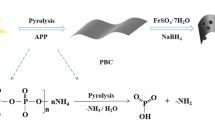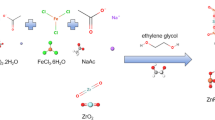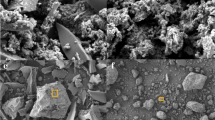Abstract
Uranium-containing wastewater poses a major threat to human health because of its toxicity and radioactivity. To address this issue, tea waste-derived porous biochar supporting the Fe–Mn bimetallic composite (FMBC) was fabricated using impregnation-pyrolysis and applied for U(VI) removal from aqueous solution. Batch experiments and characterization analysis were performed to investigate the adsorption properties and interaction mechanisms. Results showed that FMBC exhibit a maximum U(VI) removal capacity of 510.8 mg/g at pH = 5, T = 303 k, and t = 25 min. The kinetic and isotherm date fitted well with the pseudo-second-order kinetic model and Langmuir isotherm model, respectively, indicating that uranium adsorption is dominated by chemical adsorption on FMBC. FTIR and XPS analyses further confirmed that the U(VI) adsorption mechanism by FMBC was attributed to surface complexation, π–π bonding, and reduction processes. In addition, the Cationic competitive adsorption experiment further highlighted the excellent selective performance of FMBC for U(VI) removal from aqueous solutions, which is important in radionuclides' pollution treatment.












Similar content being viewed by others
References
Tang X, Zhou L, Le Z, Wang Y, Liu Z, Huang G, Adesina AA (2020) Preparation of porous chitosan/carboxylated carbon nanotube composite aerogels for the efficient removal of uranium(VI) from aqueous solution. Int J Biol Macromol 160:1000–1008. https://doi.org/10.1016/j.ijbiomac.2020.05.179
Cheira MF, Kouraim MN, Zidan IH, Mohamed WS, Hassanein TF (2020) Adsorption of U(VI) from sulfate solution using montmorillonite/polyamide and nano-titanium oxide/polyamide nanocomposites. J Environ Chem Eng. https://doi.org/10.1016/j.jece.2020.104427
Singhal P, Vats BG, Yadav A, Pulhani V (2020) Efficient extraction of uranium from environmental samples using phosphoramide functionalized magnetic nanoparticles: understanding adsorption and binding mechanisms. J Hazard Mater. https://doi.org/10.1016/j.jhazmat.2019.121353
Abdul G, Zhu X, Chen B (2017) Structural characteristics of biochar-graphene nanosheet composites and their adsorption performance for phthalic acid esters. Chem Eng J 319:9–20. https://doi.org/10.1016/j.cej.2017.02.074
Dai J, Meng X, Zhang Y, Huang Y (2020) Effects of modification and magnetization of rice straw derived biochar on adsorption of tetracycline from water. Biores Technol. https://doi.org/10.1016/j.biortech.2020.123455
Yang G-X, Jiang H (2014) Amino modification of biochar for enhanced adsorption of copper ions from synthetic wastewater. Water Res 48:396–405. https://doi.org/10.1016/j.watres.2013.09.050
Pereira L, Dias P, Soares OSGP, Ramalho PSF, Pereira MFR, Alves MM (2017) Synthesis, characterization and application of magnetic carbon materials as electron shuttles for the biological and chemical reduction of the azo dye Acid Orange 10. Appl Catal B Environ 212:175–184. https://doi.org/10.1016/j.apcatb.2017.04.060
Hua M, Zhang S, Pan B, Zhang W, Lv L, Zhang Q (2012) Heavy metal removal from water/wastewater by nanosized metal oxides: a review. J Hazard Mater 211:317–331. https://doi.org/10.1016/j.jhazmat.2011.10.016
Wan S, Qiu L, Tang G, Chen W, Li Y, Gao B, He F (2020) Ultrafast sequestration of cadmium and lead from water by manganese oxide supported on a macro-mesoporous biochar. Chem Eng J. https://doi.org/10.1016/j.cej.2020.124095
Li Y, Zhang X, Zhang P, Liu X, Han L (2020) Facile fabrication of magnetic bio-derived chars by co-mixing with Fe3O4 nanoparticles for effective Pb2+ adsorption: properties and mechanism. J Clean Prod. https://doi.org/10.1016/j.jclepro.2020.121350
Tariq MA, Nadeem M, Iqbal MM, Imran M, Siddique MH, Iqbal Z, Amjad M, Rizwan M, Ali S (2020) Effective sequestration of Cr (VI) from wastewater using nanocomposite of ZnO with cotton stalks biochar: modeling, kinetics, and reusability. Environ Sci Pollut Res 27(27):33821–33834. https://doi.org/10.1007/s11356-020-09481-x
Kong F, Zhang Y, Wang H, Tang J, Li Y, Wang S (2020) Removal of Cr(VI) from wastewater by artificial zeolite spheres loaded with nano Fe-Al bimetallic oxide in constructed wetland. Chemosphere. https://doi.org/10.1016/j.chemosphere.2020.127224
Qi J, Zhang G, Li H (2015) Efficient removal of arsenic from water using a granular adsorbent: Fe–Mn binary oxide impregnated chitosan bead. Biores Technol 193:243–249. https://doi.org/10.1016/j.biortech.2015.06.102
Xiao J, Hu R, Chen G, Xing B (2020) Facile synthesis of multifunctional bone biochar composites decorated with Fe/Mn oxide micro-nanoparticles: physicochemical properties, heavy metals sorption behavior and mechanism. J Hazard Mater. https://doi.org/10.1016/j.jhazmat.2020.123067
Zhou Q, Liao B, Lin L, Qiu W, Song Z (2018) Adsorption of Cu(II) and Cd(II) from aqueous solutions by ferromanganese binary oxide-biochar composites. Sci Total Environ 615:115–122. https://doi.org/10.1016/j.scitotenv.2017.09.220
Pal D, Maiti SK (2019) Abatement of cadmium (Cd) contamination in sediment using tea waste biochar through meso-microcosm study. J Clean Prod 212:986–996. https://doi.org/10.1016/j.jclepro.2018.12.087
Panahandeh A, Parvareh A, Moraveji MK (2021) Synthesis and characterization of γ-MnO2/chitosan/Fe3O4 cross-linked with EDTA and the study of its efficiency for the elimination of zinc(II) and lead(II) from wastewater. Environ Sci Pollut Res 28(8):9235–9254. https://doi.org/10.1007/s11356-020-11359-x
Liu J, Yang X, Liu H, Cheng W, Bao Y (2020) Modification of calcium-rich biochar by loading Si/Mn binary oxide after NaOH activation and its adsorption mechanisms for removal of Cu(II) from aqueous solution. Colloids Surf Physicochem Eng Aspects. https://doi.org/10.1016/j.colsurfa.2020.124960
Chen L, Jiang X, Xie R, Zhang Y, Jin Y, Jiang W (2020) A novel porous biochar-supported Fe-Mn composite as a persulfate activator for the removal of acid red 88. Sep Purif Technol. https://doi.org/10.1016/j.seppur.2020.117232
Philippou K, Anastopoulos I, Dosche C, Pashalidis I (2019) Synthesis and characterization of a novel Fe3O4-loaded oxidized biochar from pine needles and its application for uranium removal. Kinetic, thermodynamic, and mechanistic analysis. J Environ Manag. https://doi.org/10.1016/j.jenvman.2019.109677
Li Y, Zhu S, Liu Q, Chen Z, Gu J, Zhu C, Lu T, Zhang D, Ma J (2013) N-doped porous carbon with magnetic particles formed in situ for enhanced Cr(VI) removal. Water Res 47(12):4188–4197. https://doi.org/10.1016/j.watres.2012.10.056
Dai S, Wang N, Qi C, Wang X, Ma Y, Yang L, Liu X, Huang Q, Nie C, Hu B, Wang X (2019) Preparation of core-shell structure Fe3O4@C@MnO2 nanoparticles for efficient elimination of U(VI) and Eu(III) ions. Sci Total Environ 685:986–996. https://doi.org/10.1016/j.scitotenv.2019.06.292
Wang X, Feng J, Cai Y, Fang M, Kong M, Alsaedi A, Hayat T, Tan X (2020) Porous biochar modified with polyethyleneimine (PEI) for effective enrichment of U(VI) in aqueous solution. Sci Total Environ. https://doi.org/10.1016/j.scitotenv.2019.134575
Deng J, Li X, Wei X, Liu Y, Liang J, Shao Y, Huang W, Cheng X (2020) Different adsorption behaviors and mechanisms of a novel amino- functionalized hydrothermal biochar for hexavalent chromium and pentavalent antimony. Biores Technol. https://doi.org/10.1016/j.biortech.2020.123438
Li B, Yang L, Wang C-q, Zhang Q-p, Liu Q-c, Li Y-d, Xiao R (2017) Adsorption of Cd(II) from aqueous solutions by rape straw biochar derived from different modification processes. Chemosphere 175:332–340. https://doi.org/10.1016/j.chemosphere.2017.02.061
Teng D, Zhang B, Xu G, Wang B, Mao K, Wang J, Sun J, Feng X, Yang Z, Zhang H (2020) Efficient removal of Cd(II) from aqueous solution by pinecone biochar: sorption performance and governing mechanisms. Environ Pollut. https://doi.org/10.1016/j.envpol.2020.115001
Wang J, Fang F, Zhou Y, Yin M, Liu J, Wang J, Wu Y, Beiyuan J, Chen D (2020) Facile modification of graphene oxide and its application for the aqueous uranyl ion sequestration: Insights on the mechanism. Chemosphere. https://doi.org/10.1016/j.chemosphere.2020.127152
Liu W, Zhang L, Chen F, Wang H, Wang Q, Liang K (2020) Efficiency and mechanism of adsorption of low-concentration uranium from water by a new chitosan/aluminum sludge composite aerogel. Dalton Trans 49(10):3209–3221. https://doi.org/10.1039/c9dt04670d
Khan ZH, Gao M, Qiu W, Song Z (2020) Properties and adsorption mechanism of magnetic biochar modified with molybdenum disulfide for cadmium in aqueous solution. Chemosphere. https://doi.org/10.1016/j.chemosphere.2020.126995
Li M, Liu H, Chen T, Dong C, Sun Y (2019) Synthesis of magnetic biochar composites for enhanced uranium(VI) adsorption. Sci Total Environ 651(Pt 1):1020–1028. https://doi.org/10.1016/j.scitotenv.2018.09.259
Yu S, Wu X, He P, Liu Y, Shi K, Zhang Q, Zhang X, Li M, Lv C (2019) Preparation of Hawaii nut shell biochar/graphene sponge and study on uranium adsorption properties. IOP Conf Ser Earth Environ Sci. https://doi.org/10.1088/1755-1315/349/1/012048
Xu Z, Xing Y, Ren A, Ma D, Li Y, Hu S (2020) Study on adsorption properties of water hyacinth-derived biochar for uranium (VI). J Radioanal Nucl Chem 324(3):1317–1327. https://doi.org/10.1007/s10967-020-07160-2
Lyu P, Wang G, Wang B, Yin Q, Li Y, Deng N (2021) Adsorption and interaction mechanism of uranium (VI) from aqueous solutions on phosphate-impregnation biochar cross-linked Mg Al layered double-hydroxide composite. Appl Clay Sci. https://doi.org/10.1016/j.clay.2021.106146
Hu R, Xiao J, Wang T, Chen G, Chen L, Tian X (2020) Engineering of phosphate-functionalized biochars with highly developed surface area and porosity for efficient and selective extraction of uranium. Chem Eng J. https://doi.org/10.1016/j.cej.2019.122388
Ying D, Hong P, Jiali F, Qinqin T, Yuhui L, Youqun W, Zhibin Z, Xiaohong C, Yunhai L (2020) Removal of uranium using MnO2/orange peel biochar composite prepared by activation and in-situ deposit in a single step. Biomass Bioenerg. https://doi.org/10.1016/j.biombioe.2020.105772
Chen C, Zhao K, Shang J, Liu C, Wang J, Yan Z, Liu K, Wu W (2018) Uranium (VI) transport in saturated heterogeneous media: Influence of kaolinite and humic acid. Environ Pollut 240:219–226. https://doi.org/10.1016/j.envpol.2018.04.095
Wang Q, Cheng T, Wu Y (2014) Influence of mineral colloids and humic substances on uranium(VI) transport in water-saturated geologic porous media. J Contam Hydrol 170:76–85. https://doi.org/10.1016/j.jconhyd.2014.10.007
Ahmed MJ, Hameed BH (2018) Adsorption behavior of salicylic acid on biochar as derived from the thermal pyrolysis of barley straws. J Clean Prod 195:1162–1169. https://doi.org/10.1016/j.jclepro.2018.05.257
Chen X, Chen G, Chen L, Chen Y, Lehmann J, McBride MB, Hay AG (2011) Adsorption of copper and zinc by biochars produced from pyrolysis of hardwood and corn straw in aqueous solution. Biores Technol 102(19):8877–8884. https://doi.org/10.1016/j.biortech.2011.06.078
Chen Q, Zheng J, Zheng L, Dang Z, Zhang L (2018) Classical theory and electron-scale view of exceptional Cd(II) adsorption onto mesoporous cellulose biochar via experimental analysis coupled with DFT calculations. Chem Eng J 350:1000–1009. https://doi.org/10.1016/j.cej.2018.06.054
Yu S, Ma J, Shi Y, Du Z, Zhao Y, Tuo X, Leng Y (2020) Uranium(VI) adsorption on montmorillonite colloid. J Radioanal Nucl Chem 324(2):541–549. https://doi.org/10.1007/s10967-020-07083-y
Wu J, Wang T, Wang J, Zhang Y, Pan WP (2021) A novel modified method for the efficient removal of Pb and Cd from wastewater by biochar: enhanced the ion exchange and precipitation capacity. Sci Total Environ. https://doi.org/10.1016/j.scitotenv.2020.142150
Zhang Q, Zhao D, Ding Y, Chen Y, Li F, Alsaedi A, Hayat T, Chen C (2019) Synthesis of Fe-Ni/graphene oxide composite and its highly efficient removal of uranium(VI) from aqueous solution. J Clean Prod 230:1305–1315. https://doi.org/10.1016/j.jclepro.2019.05.193
Datsyuk V, Kalyva M, Papagelis K, Parthenios J, Tasis D, Siokou A, Kallitsis I, Galiotis C (2008) Chemical oxidation of multiwalled carbon nanotubes. Carbon 46(6):833–840. https://doi.org/10.1016/j.carbon.2008.02.012
Zhang M, Wang Y (2020) Effects of Fe-Mn-modified biochar addition on anaerobic digestion of sewage sludge: biomethane production, heavy metal speciation and performance stability. Biores Technol. https://doi.org/10.1016/j.biortech.2020.123695
Li P, Jiang EY, Bai HL (2011) Fabrication of ultrathin epitaxial γ-Fe2O3films by reactive sputtering. J Phys D Appl Phys 44(7):075003. https://doi.org/10.1088/0022-3727/44/7/075003
Wan S, Qiu L, Li Y, Sun J, Gao B, He F, Wan W (2020) Accelerated antimony and copper removal by manganese oxide embedded in biochar with enlarged pore structure. Chem Eng J. https://doi.org/10.1016/j.cej.2020.126021
Zhang X, Zhang L, Liu Y, Li M, Wu X, Jiang T, Chen C, Peng Y (2020) Mn-substituted goethite for uranium immobilization: a study of adsorption behavior and mechanisms. Environ Pollut. https://doi.org/10.1016/j.envpol.2020.114184
Acknowledgements
This work was supported by the National Natural Science Foundation of China [Grant Numbers NO51904155].
Author information
Authors and Affiliations
Corresponding author
Additional information
Publisher's Note
Springer Nature remains neutral with regard to jurisdictional claims in published maps and institutional affiliations.
Rights and permissions
About this article
Cite this article
Liu, J., Ge, Y., Wang, G. et al. Highly efficient removal of U(VI) in aqueous solutions by tea waste-derived biochar-supported iron-manganese oxide composite. J Radioanal Nucl Chem 330, 871–882 (2021). https://doi.org/10.1007/s10967-021-07981-9
Received:
Accepted:
Published:
Issue Date:
DOI: https://doi.org/10.1007/s10967-021-07981-9




